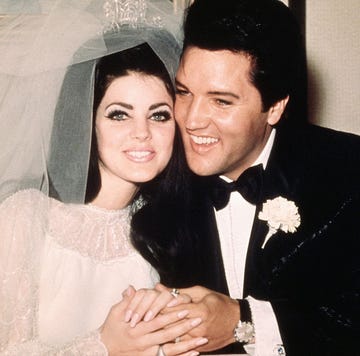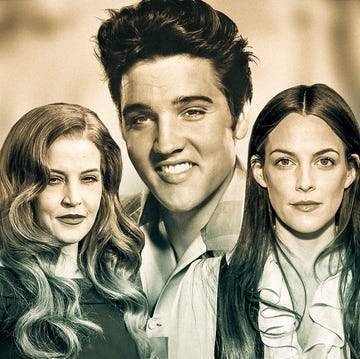The news headlines from August 16, 1977, presented a surreal impression of what was almost an alternative universe:
“ELVIS IS DEAD”
“ELVIS, KING OF ROCK, DIES AT 42”
“ELVIS PRESLEY DIES OF HEART ATTACK”
It almost seemed unbelievable. Early news reports were short, incomplete and confused. Almost five decades later, it’s still not entirely clear what happened to the “King of Rock ’n’ Roll.”
But what was unmistakably clear was that Elvis Presley, the “greatest rock and roll performer in the world,” had died that day at the relatively young age of 42—leaving fans around the world to ponder what the rest of his life and career might have looked like. Had he lived, Wednesday marks what would have been Presley’s 90th birthday.
Although his cause of death was originally claimed to be a heart attack, later toxicology reports identified high levels of several pharmaceutical drugs in the musician’s system. Many doubted it. After all, President Richard Nixon had met with Elvis and given him a badge from the Bureau of Narcotics and Dangerous Drugs. There’s even a photo to prove it.
Others just accepted the story as another drug-related death of a rock ’n’ roll star. How the cause of death changed from heart attack to prescription-drug poisoning typified the pattern of a celebrity’s fall from grace.
Presley’s fiancée discovered him incapacitated
On the day he died, Elvis Presley was at his Graceland mansion in Memphis, Tennessee, resting between concert appearances. Sometime around 2:30 p.m., his fiancée, Ginger Alden, found him lying face down on the floor of his spacious bathroom. At 2:33 p.m., a call came into Memphis Fire Station No. 29 indicating that someone at 3754 Elvis Presley Blvd. was having difficulty breathing. Ambulance Unit No. 6 sped out of the station and headed south.
While not a routine trip, local ambulances had made numerous visits to Graceland over the years to take care of fainting fans or pedestrians hit by cars along the crowded sidewalks in front of the mansion. From time to time, the mansion’s owner has also sped away in an ambulance to receive emergency medical treatment.
Within a few minutes, the ambulance neared Graceland. The vehicle made a hard left through the opened iron gates and up the curved driveway to the white-columned portico. One of Presley’s bodyguards allowed the two medics to enter the mansion. With equipment in hand, they rushed up the stairs to the bathroom where they encountered nearly a dozen people huddled over a man in his pajamas, lying prostrate on his back. The medics quickly moved in. Initially, they didn’t recognize the victim, but then noticed the thick, graying sideburns and the large medallion around the neck and realized it was Presley.
Presley was pronounced dead at the hospital
Presley’s skin was dark blue and cold to the touch. Checking for vital signs, the medics detected no pulse and no response to light from his pupils. They quickly prepped him for transport.
It took several men to lift Presley onto the stretcher. He was obese, almost bloated. The unbalanced distribution of weight made navigation difficult around corners and down the stairs. As the medics loaded Presley into the ambulance, a stocky man with white hair leaped into the back just as the doors closed. Dr. George Nichopoulos, Presley’s doctor, affectionately known as Dr. Nick, ordered the driver to take Elvis to Baptist Memorial Hospital, 21 minutes from Graceland. There was a closer option in Methodist South Hospital, which was only 5 minutes away, but Nichopoulos knew the staff at Baptist Hospital was discreet.
At the hospital, emergency personnel made efforts to revive Presley without success. He was pronounced dead at 3:30 p.m. Hospital officials understood that their actions over the next few hours would be crucially important in preparing an official announcement.
Presley’s autopsy led to an investigation into the singer’s doctor
Dr. E. Eric Muirhead, the hospital’s chief of pathology, led a highly skilled team of nine doctors as it conducted the autopsy. During the procedure, doctors found no signs of stroke, heart failure, or lung disease. They saw evidence that Presley was chronically ill with diabetes and constipation. Physical evidence indicated possible long-term use of drugs, but toxicology tests would have to confirm that. After the autopsy, Elvis’ body was released to the funeral home.
At 8:00 p.m. that same day, a news conference was held. Medical examiner Dr. Jerry Francisco took control as spokesperson for the autopsy team, even though he had only witnessed the procedure. He announced that early tests indicated Presley’s cause of death was a cardiac arrhythmia due to undetermined heartbeat—or, more simply, heart failure.
Muirhead and the other members of the autopsy team were stunned. Not only had Francisco presumed to speak for the hospital, but his conclusion didn’t match their findings. They still hadn’t made a conclusion as to the cause of death but believed drug addiction was a probable culprit. Francisco went on to say that determining the official cause of death would take days or even weeks, but that drugs were absolutely not a factor and that there was no evidence of drug abuse, which most people at the time believed meant illegal street drugs.
For a time, most people accepted this finding. But the toxicology report that came out weeks later revealed high levels of pharmaceutical painkillers such as Dilaudid, Quaalude, Percodan, Demerol, and codeine in Elvis’ body. The Tennessee Board of Health began an investigation into Presley’s death and initiated proceedings against Nichopoulos.
During the hearings, evidence was presented that Nichopoulos had written prescriptions for more than 8,000 doses of medication since 1975 and that the pattern had been escalating since then. During the hearings, Nichopoulos admitted to writing the prescriptions. In his defense, he claimed that Elvis was so addicted to pain killers that he prescribed the medications to keep Elvis away from dangerous and illegal street drugs, trying to control his addiction. The jury agreed with the doctor’s rationale and absolved him of negligence in causing Presley’s death.
In 1980, Dr. Nichopoulos was indicted again for overprescribing drugs to Presley and singer Jerry Lee Lewis but was acquitted. However, his questionable medical practice caught up with him and, in 1995, the Tennessee Board of Medical Examiners permanently suspended his medical license for overprescribing drugs to his patients.
An Elvis expert believes genetics were a factor
While overdose continues to linger as a popular theory explaining Presley’s death, a contemporary researcher believes genetics were the primary cause, rather than drug use or the singer’s lifestyle choices.
In a 2025 interview with The Mirror, author Sally A. Hoedel, who published the 2020 book Destined to Die Young, argued Presley “did not die from a drug overdose, as many people believe,” but a cardiac event. According to Hoedel, this is notable because Presley had four relatives that died of heart- or liver-related ailments in their 40s or 50s. One was his mother, Gladys, who underwent a similar four-year period of declining health before her death in August 1958.
“The fact is that much of his poor health was out of his control,” Hoedel explained. “There is a long history of premature death in his family tree. Elvis had disease or disorder in nine of the eleven systems of the body. At least five of those were present prior to fame and most likely since birth as they’re genetic in nature.
“Therefore, they could not have been caused by the stress of fame or his problem with prescription medication. In large part, he was self-medicating through a great deal of illness.”
In any case, Presley was gone and fans rushed to pay their respects.
Mourning fans converged on Graceland
On August 17, the day after Elvis died, the doors of Graceland were opened for a public viewing of Presley’s body. Crowds had gathered early that day and quickly grew to an estimated 100,000. The mourners ranged from pre-teens to middle-aged and older men and women. Many expressed genuine, open sorrow over his death. Others were more upbeat, almost festive, and eager to be part of the cultural history. Due to the extreme temperatures that day, the showing was cut short for fear the heat and humidity would disfigure Elvis’ body.
The following day, a funeral procession of 17 white Cadillacs and a hearse carrying Presley slowly made its way from Graceland to Forrest Hill Cemetery. Under heavy guard, a simple ceremony was conducted. Present were Elvis’ ex-wife, Priscilla; his daughter, Lisa Marie; his father, Vernon; and his paternal grandmother, Minnie Mae Presley. Several celebrities, including Chet Atkins, Ann-Margret, Caroline Kennedy, James Brown, Sammy Davis Jr., and of course Colonel Tom Parker, who had guided and gilded Presley’s career from the start. Elvis was laid to rest in a mausoleum alongside his mother.
After authorities thwarted an attempt to steal Presley’s coffin, his remains and his mother’s were moved to Graceland. He is now buried in the property’s Meditation Garden along with Gladys, Vernon, Minnie Mae, Lisa Marie, and his grandson, Benjamin Keough.
In his 20-plus years as an entertainer, Presley became a defining force of the times. Even today, on what could have been an important birthday milestone, Elvis remains the King to many.
Tyler Piccotti joined the Biography.com staff as an Associate News Editor and is now the News and Culture Editor. He previously worked as a reporter and copy editor for a daily newspaper recognized by the Associated Press Sports Editors. In his current role, he shares the true stories behind your favorite movies and TV shows and profiles rising musicians, actors, and athletes. When he's not working, you can find him at the nearest amusement park or movie theater and cheering on his favorite teams.















